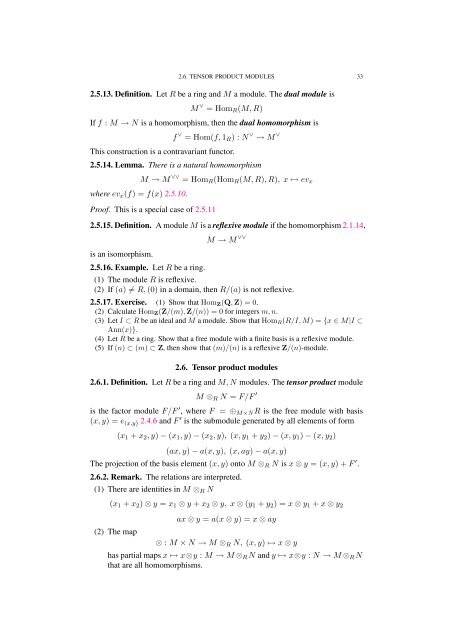Commutative algebra - Department of Mathematical Sciences - old ...
Commutative algebra - Department of Mathematical Sciences - old ...
Commutative algebra - Department of Mathematical Sciences - old ...
You also want an ePaper? Increase the reach of your titles
YUMPU automatically turns print PDFs into web optimized ePapers that Google loves.
2.6. TENSOR PRODUCT MODULES 33<br />
2.5.13. Definition. Let R be a ring and M a module. The dual module is<br />
M ∨ = HomR(M, R)<br />
If f : M → N is a homomorphism, then the dual homomorphism is<br />
f ∨ = Hom(f, 1R) : N ∨ → M ∨<br />
This construction is a contravariant functor.<br />
2.5.14. Lemma. There is a natural homomorphism<br />
where evx(f) = f(x) 2.5.10.<br />
M → M ∨∨ = HomR(HomR(M, R), R), x ↦→ evx<br />
Pro<strong>of</strong>. This is a special case <strong>of</strong> 2.5.11<br />
2.5.15. Definition. A module M is a reflexive module if the homomorphism 2.1.14,<br />
is an isomorphism.<br />
2.5.16. Example. Let R be a ring.<br />
M → M ∨∨<br />
(1) The module R is reflexive.<br />
(2) If (a) = R, (0) in a domain, then R/(a) is not reflexive.<br />
2.5.17. Exercise. (1) Show that HomZ(Q, Z) = 0.<br />
(2) Calculate HomZ(Z/(m), Z/(n)) = 0 for integers m, n.<br />
(3) Let I ⊂ R be an ideal and M a module. Show that HomR(R/I, M) = {x ∈ M|I ⊂<br />
Ann(x)}.<br />
(4) Let R be a ring. Show that a free module with a finite basis is a reflexive module.<br />
(5) If (n) ⊂ (m) ⊂ Z, then show that (m)/(n) is a reflexive Z/(n)-module.<br />
2.6. Tensor product modules<br />
2.6.1. Definition. Let R be a ring and M, N modules. The tensor product module<br />
M ⊗R N = F/F ′<br />
is the factor module F/F ′ , where F = ⊕M×NR is the free module with basis<br />
(x, y) = e (x,y) 2.4.6 and F ′ is the submodule generated by all elements <strong>of</strong> form<br />
(x1 + x2, y) − (x1, y) − (x2, y), (x, y1 + y2) − (x, y1) − (x, y2)<br />
(ax, y) − a(x, y), (x, ay) − a(x, y)<br />
The projection <strong>of</strong> the basis element (x, y) onto M ⊗R N is x ⊗ y = (x, y) + F ′ .<br />
2.6.2. Remark. The relations are interpreted.<br />
(1) There are identities in M ⊗R N<br />
(x1 + x2) ⊗ y = x1 ⊗ y + x2 ⊗ y, x ⊗ (y1 + y2) = x ⊗ y1 + x ⊗ y2<br />
(2) The map<br />
ax ⊗ y = a(x ⊗ y) = x ⊗ ay<br />
⊗ : M × N → M ⊗R N, (x, y) ↦→ x ⊗ y<br />
has partial maps x ↦→ x⊗y : M → M ⊗R N and y ↦→ x⊗y : N → M ⊗R N<br />
that are all homomorphisms.
















